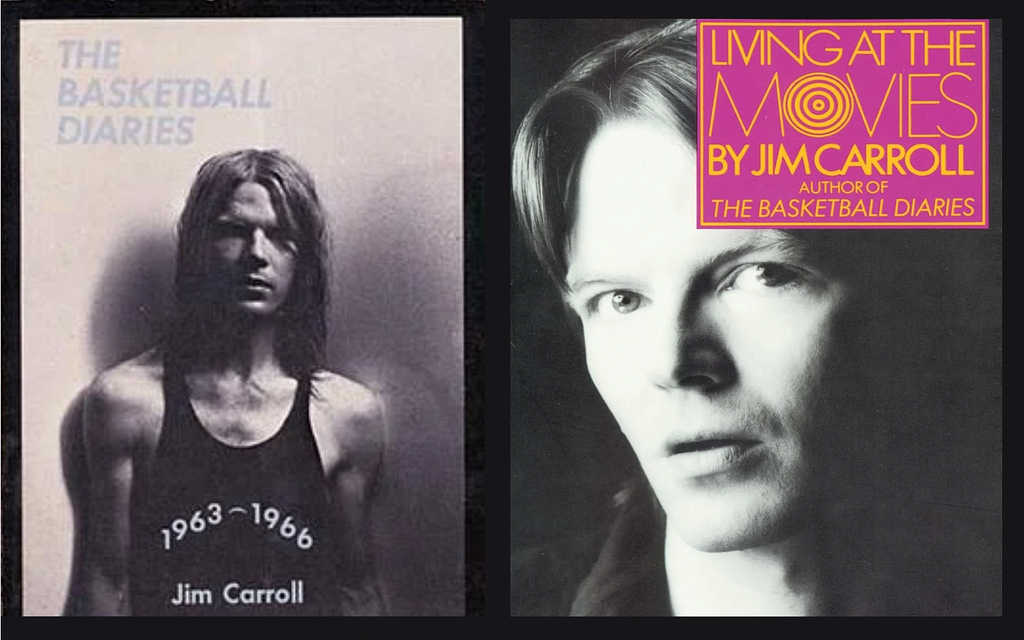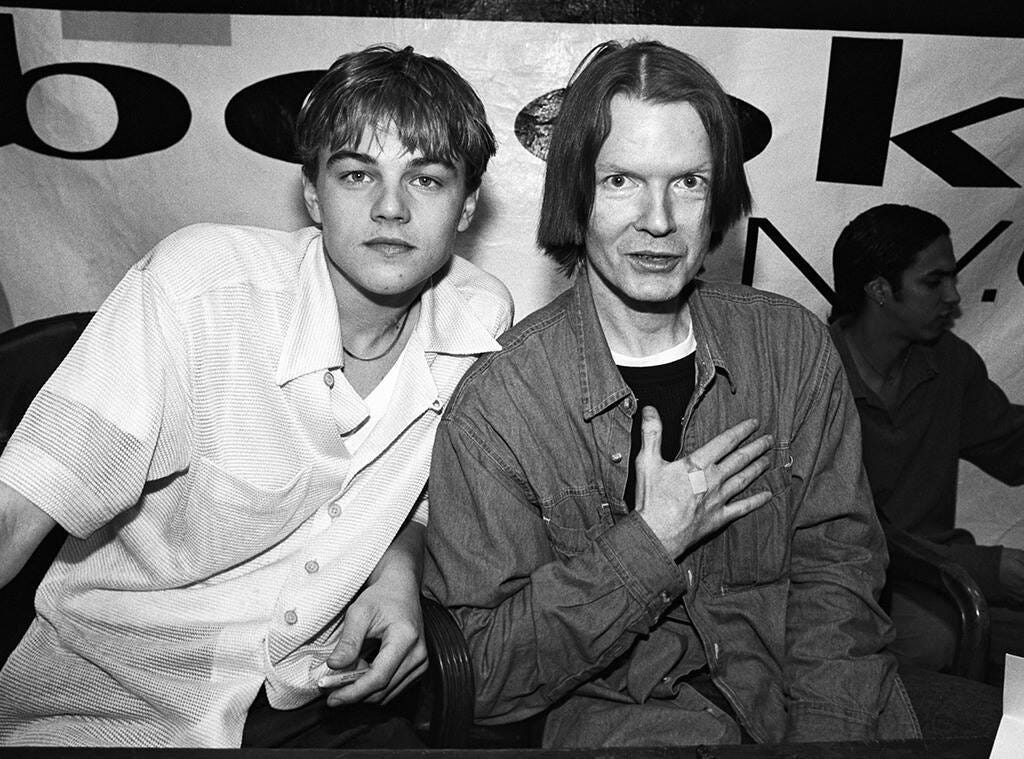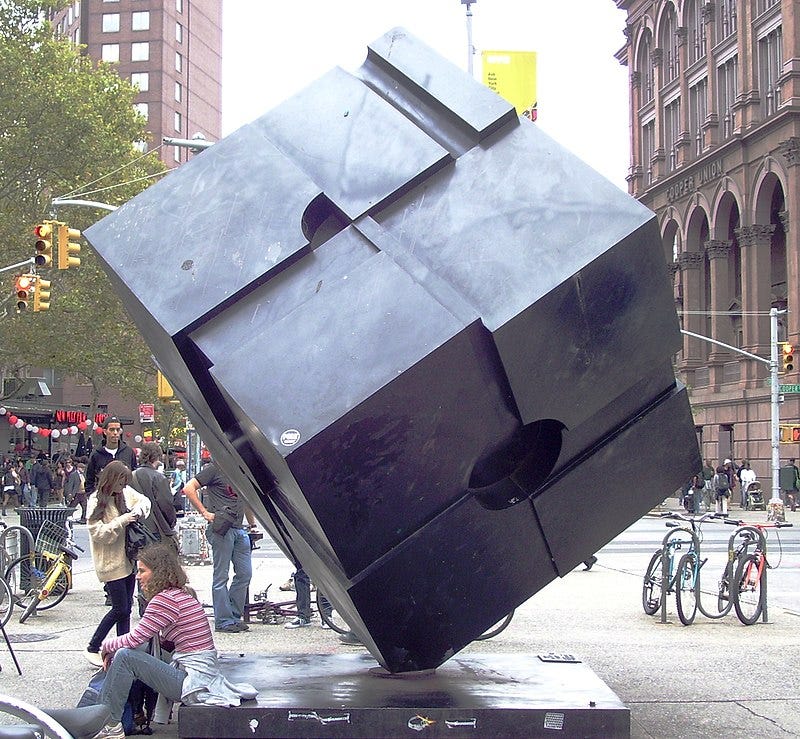
Like so many things in the nineties… it all started with Leonardo DiCaprio. As a preteen, I was obsessed with this dreamy actor on the verge of cementing his movie star status with Titanic. I wanted everything Leo-related: any movie, any teen magazine profile, any internet photo spread. I wasn’t alone in my obsession, and one evening, my friends and I gathered for a sleepover to watch a rented VHS tape of The Basketball Diaries, a biopic starring DiCaprio as a young basketball prodigy whose life takes a dangerous turn when he begins using heroin. While the movie was eye-opening for the frank (and at times melodramatic) depictions of substance use and sex work, it also opened my eyes to something else: poetry.
The Basketball Diaries was based on the memoir of the same name by Jim Carroll, a renowned poet, author, and musician. Both the memoir and its film adaptation portray Carroll’s early adolescence as he and his basketball teammates wreaked havoc in the city, began experimenting with drugs and girls, and endured the abuses of Catholic school authority figures. Carroll ultimately became part of the second generation of New York School poets.

During the film, DiCaprio as Carroll recites his poem “Little Ode on St. Anne’s Day.” The simple but smart verses stuck with me. It didn’t take me long to find my parents’ yellowed copy of Living at the Movies, Carroll’s third poetry collection, published in 1973. (His first collection was published when he was still a teenager.) On the cover is Carroll himself, staring not just into the camera but at the reader. He shared the same striking androgynous beauty that made DiCaprio a shoo-in for his starring role in The Basketball Diaries. Carroll’s distinctive eyes were haunted, and they were intelligent, drawing the reader into his world even before they opened his book.
The poems in Living at the Movies provided a lens for how I saw and experienced young love, New York City, and my own poetry. My own teen years were much tamer than Carroll’s; looking back, I’m startled to realize that I watched The Basketball Diaries around age twelve, which is how old he was when he started writing the groundbreaking memoir. Compared to the young poet, I was a very naïve child stunned by the difference between his life experience and my own.
Still, I would sit in the sun for hours, reading and rereading his words, committing what I could to memory. I’d put the book down periodically to close my eyes, feeling dazed and overwhelmed by his elegance and energy. Even now, nearly thirty years after I first encountered this slim collection, it remains a dog-eared and much-loved touchstone. I turn to it to find someone else with a realistic yet romantic view of New York, and I turn to it for comfort. As a poet myself, I also turn to it for inspiration, learning from Carroll’s line breaks, punctuation, and dreamy imagery.
One of the most striking poems in the collection is “Withdrawal Letter,” which incorporates many of the themes in Carroll’s work: heroin use, doomed love, the push and pull of New York City, and a hint of the Catholicism that he was exposed to as a child. He describes a late winter day in the city:
and “They,” well, they surround you in N.Y.C.
on subways and park entrances near the fountain
but can you turn your head to the fountain?
I sit with my long hair breathing spray
In a city as populous as New York, one is always surrounded, but here Carroll focuses on a serene experience in one of the city’s parks. (I like to imagine Washington Square Park, with its eye-catching fountain, as the setting for “Withdrawal Letter.”) He invites the readers in and encourages us to join him, to turn toward the fountain to feel the same refreshing spray that he feels. The use of “N.Y.C.” in the poem also feels like a shared intimacy; he nicknames the city as if it’s a friend he and the reader both know well. And it is — although just as one might never truly know everything about a lover, one can never truly know all of New York.
In the same poem, he also describes seeing a palomino horse in Kansas that brought him to tears, but admits:
though I nodded mostly through Kansas,
treating someone I love badly, though
confusion results, and from there one realizes
it is not alone, anything
in the end, and one loves again…
By revealing that he hurt someone (likely due to heroin use as the nodding suggests), the tone for this poem is more regretful. One can see Carroll sitting at the fountain, contemplating the mistakes he made with his lover, and one wonders if the urge to use heroin is still with him. As the poem ends, he ties his love affair with heroin to his disillusionment with the Catholic Church and with romantic love:
and can I bear all those other scenes
so many other words might shoot up?
I want my hands and neck to be free and clear
no crucifixes and no rings.
these hands that hold the blood that rises
to a level where joy is pumped
visually to one’s heart
in the serpent red dawn
Coincidentally there is also a Manhattan in Kansas. Did Carroll know this? Did he spend any time in Manhattan, Kansas? There is another Kansas-related poem in “Living at the Movies,” “To the Secret Poets of Kansas,” which begins:
Just because I can’t understand you
it doesn’t mean I hate you… like
when you go on continuously how
you cannot tolerate skyscrapers or cabdrivers
ㅤㅤㅤㅤmaniac faces on Fifth…
In what may be a sort of love letter to the person he hurt badly in Kansas from “Withdrawal Letter,” Carroll gently debates the virtues of city living, and acknowledges that difference between his daydreamy self and someone who makes him think logically.
and if you don’t feel like running across streets here
you simply get run over and that means pain and boredom…
now isn’t it amazing how you bring out logic in my poems.
That last line has always had a striking kind of sweetness and humor to it. I thought so as a teenager, and now decades after initially reading “To the Secret Poets of Kansas,” I can relate to it even more keenly. My partner is the more logical one who has not only helped me pull out different things in my writing, but in my life as well.
The relationship a New York City resident (and especially a lifetime New Yorker like Carroll) has with the city is ever changing. Someone can be delighted with its chaotic energy one moment, then frustrated by its multitude of problems the next. One day as I sat reading in Central Park, I was overcome by the scent of horse manure. A little bit goes a long way. I was thinking of relocating to a better spot, although I felt prematurely defeated by the crowds in the park on the last warm day of summer.
Then I heard a voice declare conspiratorially, “The devil has gotten into them.” I looked up in time to see an elderly woman pushing a stroller, sharing her paranoid thoughts with a rapt infant. The woman sitting next to me at the park bench made eye contact with me and asked, “The devil?” I was immediately in love with the city again. Tiny moments of connection between strangers happen all the time, with or without the devil’s involvement.
Like Carroll, I also lived in Inwood, a small neighborhood in upper Manhattan, for several years in my twenties and thirties. Although he had passed away in 2009, two years before I moved there, I’d often imagine this special part of the city through his eyes. When I sat outside at Muscota Marsh, I’d gaze up at the C Rock, a rocky cliff towering above the Harlem River. I wondered if Carroll had also sat there, reading or writing and looking up at the giant blue Columbia University logo painted on the rock. According to The Basketball Diaries, he had jumped off C Rock into the river himself, a rite of passage for young, mostly male New Yorkers.

Carroll’s love for the city remains strong throughout the collection, even when acknowledging the things about New York City that don’t grace any postcards or souvenir t-shirts. “Maybe I’m Amazed” delves into the darker side of New York City and the effects of substance use. Remembering someone, the narrator describes:
Marty was found dead by the man literally
blue 12 hours after falling out
at the foot of the Cloisters
with its millions in rare tapestry
and its clear view of the Hudson
The Cloisters, which is part of the Metropolitan Museum of Art, is a serene oasis located at the top of Fort Tryon Park in Inwood. The museum replicates a medieval monastery, and includes both beautiful gardens surrounded by medieval architecture as well as tons of art and artifacts from the Middle Ages, including the Unicorn Tapestries that Carroll references in this poem.
The Unicorn Tapestries fill one whole room at The Cloisters; each one reveals another stage in the unicorn hunt, from the unicorn sitting peacefully at a fountain to it being butchered by the hunters. The juxtaposition of the narrator’s deceased friend and the doomed unicorn show the callousness toward death (especially death of “others” like substance users or unicorns) in both medieval and modern society.

Admittedly part of the reason I ended up living in Inwood was because Carroll spent much of his life there. He was raised there and later returned to the neighborhood; he was living right down the hill from my future apartment when he passed away in 2009. The neighborhood is filled with beautiful parks and has a friendlier feel than many other parts of Manhattan, which was part of why it enticed me, but the Carroll connection was always in the back of my mind when I signed my lease and moved into my tiny but beloved apartment.
Carroll was only sixty when he died, and in his generation, he knew a shocking number of people who passed away too young. One of the most well-known songs by his musical group The Jim Carroll Band was 1980’s “People Who Died,” which was an energetic punk song with chilling lyrics. The grim ode honors his friends who died from cancer, the Vietnam War, drug overdoses, mental illnesses and other causes, ending with the bittersweet closing line, “They were all my friends, and they died.”
While Carroll experienced a lot of loss and shared it in his poetry and music, he also leans heavily into romance, sex, and a general appreciation for women’s beauty. “Love Rockets” is not only my favorite poem in the collection but also my favorite poem, full stop. It’s another poem set in late winter, and Carroll opens with a description of “Wet leaves along the threshold of the mid-day.” He drops readers immediately into the blustery March day, imagining a sunnier spot:
I suppose I’d rather be sitting in Samoa now
sipping a quart of Orange Julius and being fanned
by Joey Heatherton in black tights and white glossy lipstick.
Like all of us, Carroll revels briefly in this vivid fantasy world of warm beaches, cool drinks, and a gorgeous movie star cooling him down. Ultimately, he returns from this dreamland and gets to the heart of what he knows he needs to do:
I’m here. and I have something to say,
as well as something to take care of.
And that something is probably more important than
you realize. I like the sky (don’t you) its warmth, its friendliness,
I’m not going to let all this fucking soot taint that terrific blue.
I want to believe this poem is about Carroll’s need to share this urgent proclamation with a loved one: “I’m not going to let all this fucking soot taint that terrific blue.” I’ve read “Love Rockets” dozens of times; that line never fails to lift me. The acknowledgment of the pain, agony, and terror of life — the “fucking soot” — always feels like the narrator getting real with me. The poem recognizes the bleakness of life before reminding me to look for hope — “that terrific blue” — that still persists.
Going from blue to green, Carroll’s poem “The Green Bus” opens with the strangely dreamy inquiry: “What time is it in your bedroom?” The idea of someone asking this intimate but unusual question immediately draws the reader into the romance and sexiness of the poem. It ends as it begins, with a series of questions:
(I don’t know from your bedroom what you’re thinking,
ㅤㅤㅤㅤsaid the “person” ㅤㅤㅤㅤdo you want to take in a movie,
and go home after and fuck maybe?”
ㅤㅤㅤㅤㅤㅤㅤㅤㅤㅤㅤㅤㅤyou are warm today and the climate
ㅤㅤㅤㅤㅤㅤㅤㅤㅤㅤㅤㅤㅤㅤㅤㅤis happy and welcomed
shall we walk, then, to the park?
ㅤㅤㅤㅤㅤㅤnear the fountain?
ㅤㅤㅤㅤㅤㅤㅤㅤㅤㅤshall we sit in the grass?
The juxtaposition of the casual invitation to have sex and the old-fashioned invitation to sit in the park awakens both sexual and romantic curiosity in the reader — and one would imagine the subject of “The Green Bus.” It’s also a perfect depiction of young love: The invigorating unknowns in a new relationship (“I don’t know from your bedroom what you’re thinking”) combine with the lust and desire people feel when they’re seeing someone new. It’s easy to flash back to the heady rush of early romances while reading “The Green Bus.”
Possibly the most romantic poem in “Living at the Movies” is “The Narrows” (written for Carol Kane.) It features a narrator ardently in love with someone who may not be as eloquent in her expressions of love.
you were thinking about a red curtain
that we might hide behind. I was
thinking about the freedom of your shadow,
last night, when this livid sky unfolded
its vault of a thousand swords and the air
we were breathing seemed our own.
Even if he and his lover are sharing the same air, they might not be sharing the same thoughts and feelings. Does it pain the narrator that the subject of his poem is thinking about hiding behind a curtain? Or are they more on the same page than he seems to think? He goes on to say:
I’m glad that you’re able to breathe,
I’m glad that you’re able to distinguish me
from the lights along the thruway.
I mean don’t both of us illuminate
The direction which you are taking?
The unknowns in a relatively new relationship are part of what make it alluring. Yet here he sees himself and his lover united, headed in the same direction, and he expresses his happiness that his lover is able to see him for who he really is.
I’d like to watch myself holding you
above the cool shore of something really vast
like a vast sea, or ocean.
The romance of these lines conjures a limitless world, occupied by just the narrator and his lover. They’re facing the world together. (Uncannily enough, this also evokes a famous scene in DiCaprio’s more well-known film “Titanic,” where he holds Kate Winslet in an exhilaratingly romantic embrace on the bow of the doomed ship.)
Sensuality is laced through much of Carroll’s work in “Living at the Movies.” In “Poem,” the narrator begins:
Yesterday you past
into your lips… your hips
and your breasts
a poor unconsummated memory
The focus on women’s bodies is a frequent theme in his poetry without ever feeling explicit or gratuitous. As a young person coming to grips with my own identity as a bisexual woman I dreamed about women as Carroll did, while also wanting to be the kind of woman the poet dreamed about.
Describing the relationship in this poem, the narrator calls it both “tragic” and “silly,” but ultimately leaves readers with this memory:
but sometimes it was on a sweet log
on a long walk after dinner
in your windy warm energy jeans
fingers touching.
The phrase “windy warm energy jeans” has always stuck with me. As a teen, I had a pair of beloved jeans (passed down to me by my babysitter whom I had a huge crush on). I thought of them as my “windy warm energy jeans.” They were softened after so many washings, colored a delicate pale blue, and fit perfectly. They worked in the summer, but they also worked in the autumn. I always felt an extra bump of confidence when wearing them — after all, they had belonged to the beautiful older girl from down the street, and unbeknownst to her, I felt a connection to her each time I wore them.
“Poem” also celebrates romance, but this time, it’s the simpler everyday details that go into a relationship. The two people in the poem are out running errands on a spring day in New York City, separating to accomplish what they need to just like any other couple in the city:
you go west on 8th St. and buy something mystical to wear
and I’ll simply tuck my hands into my corduroy pockets
and whistle over to Carter’s for the poster he promised me.
Unlike some of Carroll’s other love poems like “The Green Bus,” “Poem” is more down-to-earth; it celebrates the small moments in long-term relationships.

The narrator continues:
I like the idea of leaving you for a while
knowing I’ll see you again while boring books
W.H. Auden, and movie schedules sustain my isolation
and all the while my mind’s leaning on you like my body
would like to lean on you below some statue in Central Park
in the lion house at the Bronx Zoo on a bed in Forest Hills on a
ㅤㅤㅤㅤbus.
One of the best things about being comfortable in a relationship is that you can appreciate missing each other and confidently know you’ll ultimately be reunited. When the two meet up at the end of the poem, he says:
there you are in the wind at Astor Place reading
a book and breathing in the air every few seconds
ㅤㅤㅤㅤㅤㅤㅤㅤㅤㅤㅤㅤㅤyou’re so consistent.
I love imagining both people in the poem. The observer who gets to enjoy seeing his love enjoying her book peacefully, and the observed, who is comfortable at Astor Place, the object of so much adoration. I have similar memories of splitting up for the day to get things done — my girlfriend off on her eternal quest for the perfect shoes, me off to The Strand to continue filling our apartment with books — before finding each other at a Manhattan meeting spot later. After wandering the streets and maneuvering around the crowds, there’s nothing better than spotting your love and quietly observing them before a romantic reunion.
The world has changed in many ways since “Living at the Movies” was published in the seventies, but so much has also stayed the same. The streets of New York still hold as much wonder and danger as Carroll depicted (and lived through), and the substance use prevalent in his circle is unfortunately something that’s still causing the deaths of young artists, musicians, and poets in the present. But his romanticism is reflected in today’s world, too. Decades after the collection’s initial publication, Carroll’s reminder in “Love Rockets” can still give readers hope, even on our darkest days: “I’m not going to let all this fucking soot taint that terrific blue.”
Poetic Conversations: Jim Carroll’s “Living at the Movies” was originally published in ANMLY on Medium, where people are continuing the conversation by highlighting and responding to this story.
